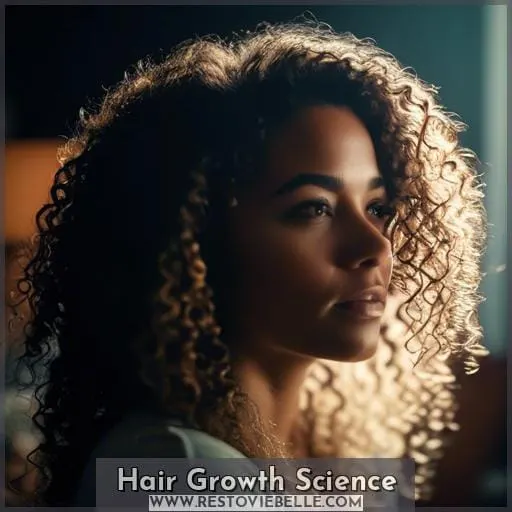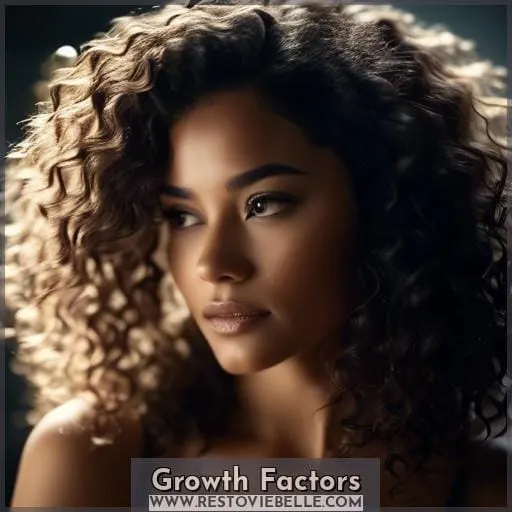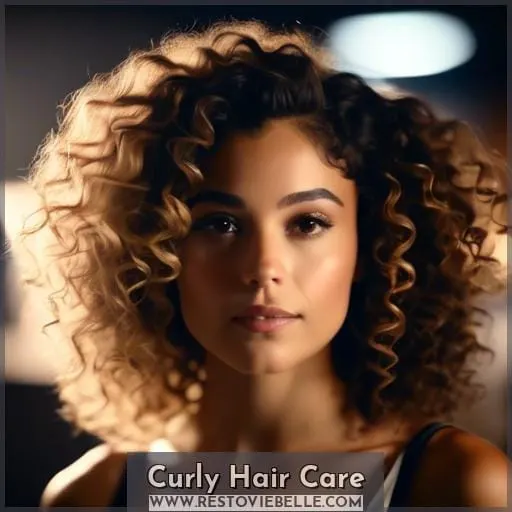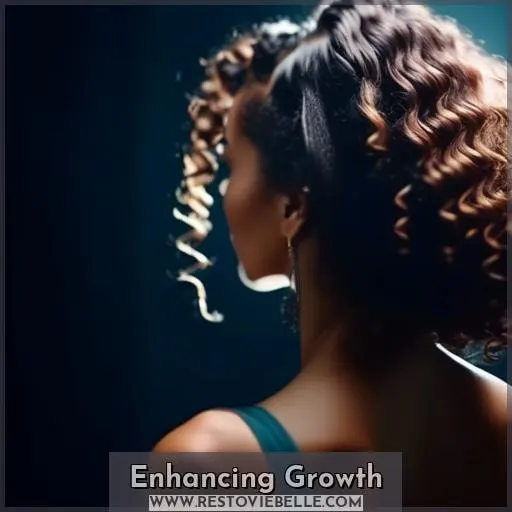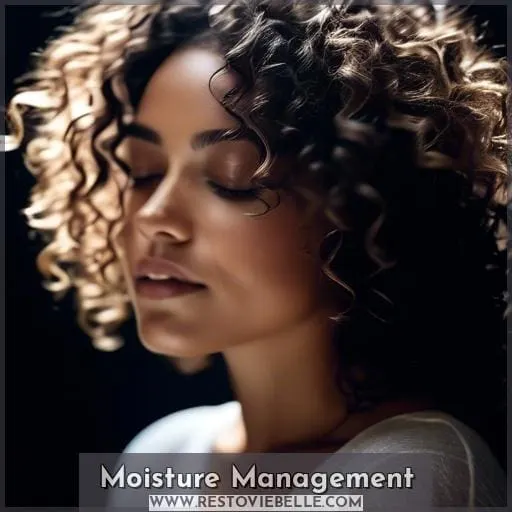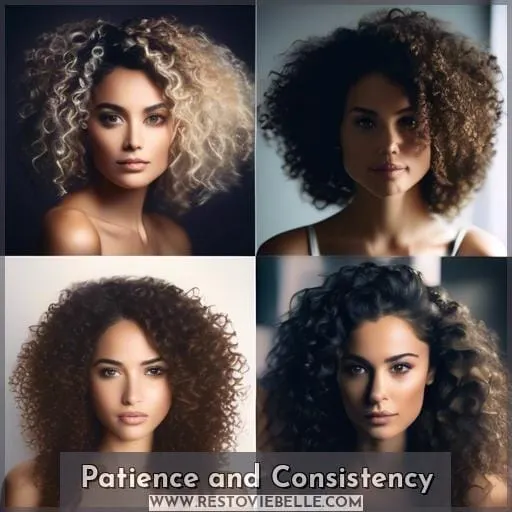This site is supported by our readers. We may earn a commission, at no cost to you, if you purchase through links.
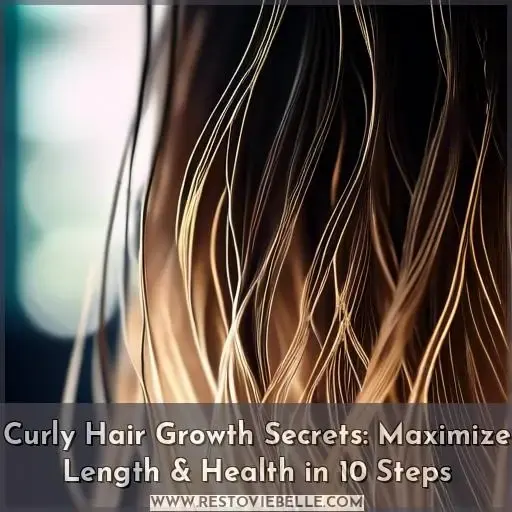 Embarking on a journey to grow your curly hair can often feel like navigating a labyrinth of myths and misconceptions. Does curly hair grow slower? Let’s unravel the truth and guide you through maximizing your curls’ length and health.
Embarking on a journey to grow your curly hair can often feel like navigating a labyrinth of myths and misconceptions. Does curly hair grow slower? Let’s unravel the truth and guide you through maximizing your curls’ length and health.
With a blend of science and tailored care, we’ll explore how genetics, hair growth phases, and proper nourishment play pivotal roles in your hair’s growth rate. From debunking myths to introducing a regimen that cherishes your unique curl pattern, this article is your compass to achieving lush, vibrant curls.
Dive into our 10-step guide, designed with your hair’s needs in mind, to unlock the secrets of flourishing curly hair.
No, curly hair does not inherently grow slower than straight hair. The perception of slower growth is due to its coiled structure, which can make length gains less visible.
Table Of Contents
- Key Takeaways
- Hair Growth Science
- Debunking Myths
- Growth Factors
- Curly Hair Care
- Avoiding Damage
- Enhancing Growth
- Styling Tips
- Moisture Management
- Protective Styling
- Patience and Consistency
- Frequently Asked Questions (FAQs)
- How does the water hardness in my area affect curly hair growth and health?
- Can certain hairstyles or hair accessories slow down the growth of curly hair?
- How do hormonal changes, such as pregnancy or menopause, specifically impact the growth rate and texture of curly hair?
- Is there a difference in growth rate and health between naturally curly hair and chemically treated curls?
- How does the microbiome of the scalp influence curly hair growth and its overall health?
- Conclusion
Key Takeaways
- Curly hair does not inherently grow slower than straight hair. The coiled structure just makes length gains less visible.
- Texture and strand shape like curly, coily, straight, etc. are determined by genetics.
- Hair growth rates vary by ethnicity. Asian hair grows the fastest while African hair grows the slowest.
- Proper moisture through cleansing, conditioning, and hydrating products is key for optimal curly hair growth.
Hair Growth Science
Understanding the science behind hair growth is key to maximizing the length and health of your curly locks.
Your hair goes through three main phases: anagen, catagen, and telogen. Genetics play a crucial role in determining how fast it grows.
By grasping these concepts, you’ll be better equipped to tackle any growth challenges and make informed decisions about your hair care routine.
Anagen, Catagen, and Telogen Phases
Understanding your hair’s growth cycle is crucial in overcoming hair growth challenges.
Anagen duration, or the growth phase, is pivotal as it directly influences your hair’s length. Each hair follicle undergoes its own pattern within this cycle, impacting your overall hair growth journey.
Recognizing these growth stages helps identify potential hair growth obstacles, from nutritional deficiencies to improper care. By focusing on extending the anagen phase through proper nutrition and scalp care, you can navigate these challenges and foster a healthier, more vibrant curl pattern.
Genetics and Hair Growth Rate
Your genes are the maestros conducting the symphony of your hair’s lifecycle, influencing not just the color and texture, but also how long your hair spends in the anagen phase—the key to length.
Ethnic differences do play a part; for instance, Asian hair typically grows the fastest, while African hair has the slowest rate due to its spiral structure. The texture variations and strand shape, especially in curly hair, are also genetically dictated.
So, while you might envy someone’s long, flowing locks, remember that curly hair growth is largely a genetic lottery. Your curl pattern and the spring factor of your curls are inherited traits that can affect how your hair grows and appears over time.
Debunking Myths
You might’ve heard that curly hair grows slower than straight hair, but that’s not quite true. Your hair’s growth rate is largely determined by genetics, not the curliness of your strands.
While it’s true that the spiraled structure of curly hair can make length gains less noticeable, rest assured that your curls are growing at a similar pace to other hair types.
Curly Vs. Straight Growth Rates
You might’ve heard that curly hair grows slower than straight hair, but this is a myth. In reality, the growth rate of your hair is largely determined by genetics, not the texture.
While it’s true that curly hair can appear to grow more slowly, this is because the coils and spirals can make it seem like it’s taking longer to gain length. To maximize your curly hair growth, focus on maintaining moisture, as curly hair is prone to dryness which can lead to breakage.
Genetics play a pivotal role in the anagen phase duration, which directly influences hair length and growth rate. So, if you’re aiming for longer curls, remember that moisture, proper care, and a healthy lifestyle are your curly hair growth secrets.
Don’t let hair growth myths discourage you; with the right hair growth tips, you can achieve the length you desire.
Misconceptions About Curly Hair
Let’s tackle some common misconceptions head-on.
It’s not your hair type but rather your genetics that play the biggest role in hair growth.
Misunderstandings about curl patterns and care routines often lead to unnecessary hair growth problems. Remember, healthy hair thrives with the right hair care, regardless of its type.
Solutions to enhance growth focus on nurturing your unique curl pattern and addressing your specific needs. Don’t let myths hold you back; understanding and innovation in your hair care routine can unlock the secret to longer, healthier locks.
Growth Factors
When considering the growth factors of curly hair, it’s essential to focus on two critical aspects: diet and hydration, and scalp care.
Your diet plays a pivotal role in hair health, with foods rich in vitamins, minerals, and hydration supporting robust growth. Ensuring your body is well-hydrated helps maintain a healthy scalp environment, crucial for hair growth.
Scalp care, including gentle cleansing and regular massages, stimulates blood flow, promoting healthier and potentially faster hair growth. These practices lay the foundation for maximizing the length and health of your curly hair.
Diet and Hydration
To bolster your curls, consider your nutrient intake as a cornerstone of hair vitality.
- Hydration Benefits: Amp up water consumption to keep your scalp health optimal and strands supple.
- Vital Vitamins: Integrate hair growth vitamins like biotin and vitamin E into your diet for robust follicles.
- Supplement Savvy: Complement your hair care routine with hair growth supplements that target specific deficiencies.
Adequate hydration and a nutrient-rich diet are pivotal hair growth factors. They not only enhance the effectiveness of hair growth products but also support overall hair growth treatments, ensuring your curls thrive.
Scalp Care
To nurture your scalp and promote hair growth, consider the following table highlighting key practices:
| Scalp Massage | Product Selection | Deep Conditioning |
|---|---|---|
| Stimulates blood flow, enhancing follicle health. | Choose sulfate-free, hydrating products. | Intense moisture treatment for curls. |
| Can be done with fingertips or massaging tools. | Avoid harsh chemicals that strip natural oils. | Helps repair and strengthen hair. |
| May increase hair thickness and growth rate. | Select products with natural, nourishing ingredients. | Prevents moisture loss from root to tip. |
| Regular practice can improve hair growth struggles. | Anti-frizz techniques protect curl integrity. | Protective hairstyles aid in length retention. |
Incorporate scalp massages into your routine to stimulate blood circulation, which can help with hair growth difficulties. When selecting products, opt for those that are gentle and designed to maintain the health of your curls.
Deep conditioning is crucial for curly hair, providing the hydration needed to combat frizz and maintain hair strength. Embrace protective hairstyles to minimize stress on your strands, aiding in the battle against hair growth struggles.
Curly Hair Care
To kickstart your journey towards healthier, longer curls, it’s essential to focus on two critical aspects: gentle cleansing and deep conditioning.
Opting for sulfate-free shampoos or co-washing methods can significantly reduce the harsh stripping of natural oils, which is vital for maintaining the moisture balance in your curly hair.
Moreover, incorporating deep conditioning treatments into your routine not only hydrates and nourishes your hair shaft but also improves its elasticity, shine, and overall health, making it more manageable and less prone to breakage.
These steps are foundational in creating an optimal environment for curly hair growth and health.
Gentle Cleansing
When it comes to nurturing your curls, gentle cleansing is paramount. Opting for sulfate-free shampoos and embracing co-washing can significantly enhance the health and appearance of your curly hair. Sulfates, commonly found in many shampoos, can strip your hair of its natural oils, leading to dryness and frizz.
This is particularly detrimental for curly hair, which naturally tends to be drier and more prone to damage.
Instead, choose sulfate-free shampoos that cleanse your scalp and hair without harsh chemicals. These shampoos maintain the essential moisture balance, ensuring your curls remain hydrated and less susceptible to breakage.
For an even gentler approach, consider co-washing. This method involves using a conditioner or a specially formulated co-wash product to cleanse your hair. It relies on the friction from massaging the product into your scalp to remove dirt and buildup, preserving even more of your hair’s natural oils.
Incorporating deep conditioning treatments and leave-in conditioners into your routine further boosts hydration, promoting healthier, more resilient curls. Remember, the key to maximizing your curly hair’s potential lies in maintaining its natural moisture and minimizing stress from harsh ingredients.
Deep Conditioning
Deep conditioning is essential for maintaining the health and vitality of your curly hair. It’s not just about slathering on any conditioner; it’s about choosing the right types and applying them effectively to reap the maximum benefits.
Conditioner frequency is key—too much can lead to over-moisturized, limp curls, while too little can leave your hair parched and prone to breakage.
When you deep condition, focus on the ends of your hair, which are the oldest and most damaged parts. Conditioner application should be thorough, ensuring even coverage. There are various conditioner types to consider, from protein-rich formulas that strengthen to hydrating ones that add moisture without weighing down your curls.
The benefits of deep conditioning are numerous: enhanced elasticity, reduced frizz, and a healthy shine that reflects your hair’s natural beauty. If you’re looking for conditioner alternatives, natural DIY options can also be effective, incorporating ingredients like aloe vera, coconut oil, or honey for a personalized touch.
Avoiding Damage
To safeguard your curly hair’s health and maximize its growth, it’s essential to focus on avoiding damage.
Firstly, protect your locks from the harsh effects of heat styling by using heat protectants. These products form a barrier that minimizes heat damage, keeping your curls intact and preventing dryness.
Secondly, regular trims are crucial. Trimming your hair every few months helps eliminate split ends, which can otherwise travel up the hair shaft, causing further breakage and making your hair appear shorter and less healthy.
By adhering to these practices, you’ll ensure your curls remain vibrant, healthy, and on track for optimal growth.
Heat Styling Protection
Continuing from the importance of deep conditioning for curly hair, let’s delve into the crucial step of protecting your curls during heat styling.
-
Use Heat Protectants: Before you reach for that flat iron or curling wand, spritz on a heat protectant. These products form protective barriers, safeguarding your strands from high temperatures.
-
Styling Techniques: Opt for lower heat settings and avoid passing the iron over the same section repeatedly. This minimizes potential damage and helps maintain your curl’s integrity.
-
Anti-Frizz Products: To combat any frizz that might arise from heat styling, incorporate anti-frizz products into your routine. They can help keep your curls defined and smooth after heat application.
Regular Trims
Regular trims are a non-negotiable part of maintaining your curly hair’s health and beauty. By snipping those split ends, you prevent breakage, ensuring your curls remain strong and resilient.
This proactive step is crucial for shape retention, as it keeps your hair looking well-defined and voluminous. Don’t let the fear of losing length deter you; trimming is actually a growth strategy. By regularly cutting off dead ends, you enhance volume and maintain the health of your curls, which in turn supports length retention over time.
Enhancing Growth
To enhance the growth of your curly hair, it’s essential to focus on a balanced diet and regular scalp massages.
Including nutrient-rich foods in your meals can provide the vitamins and minerals necessary for healthy hair growth.
Additionally, massaging your scalp can stimulate blood flow, encouraging stronger and potentially faster hair growth.
Balanced Diet
To seamlessly transition from the topic of avoiding damage to enhancing growth through a balanced diet, it’s crucial to understand the profound impact nutrition has on hair health. Nutritional deficiencies, particularly in protein, vitamin B12, and iron, can significantly hinder hair growth and even lead to hair loss.
Ensuring adequate protein intake is foundational, as hair follicles are primarily made of protein.
Vitamin B12 plays a pivotal role in cell production, including those of hair follicles. A lack of B12 can result in hair thinning and loss. Similarly, iron is essential for hemoglobin production, which carries oxygen to your cells, including those responsible for hair growth.
An iron deficiency can starve hair follicles of oxygen, leading to weakened hair and potential loss.
Incorporating hair growth supplements might be beneficial if you’re unable to meet your nutritional needs through diet alone. However, it’s always best to consult with a healthcare professional before starting any new supplement regimen.
By addressing these nutritional gaps, you can create a solid foundation for healthier, stronger hair growth.
Scalp Massages
Continuing from the importance of a balanced diet for hair health, let’s delve into scalp massages, a key practice for enhancing growth.
Scalp massages not only promote relaxation and stress reduction but also boost blood flow, which is vital for follicle stimulation. This increased circulation delivers essential nutrients and oxygen to your hair roots, supporting the anagen phase of the hair growth cycle.
By regularly massaging your scalp, you’re nurturing the very foundation of hair growth. Remember, a healthy scalp is the bedrock of healthy hair. So, take the time to gently work your fingers across your scalp, or use a massaging tool, to invigorate this critical area and encourage robust hair growth.
Styling Tips
When it comes to nurturing your curly hair and encouraging growth, the way you style it plays a pivotal role.
Opting for low-manipulation styles and mastering detangling techniques can significantly reduce breakage and maintain your hair’s health. These methods allow your curls to thrive by minimizing stress on your strands, ensuring that your hair’s growth isn’t hindered by damaging practices.
Low-Manipulation Styles
Continuing your journey to luscious curls, consider low-manipulation styles that protect and maintain your hair’s integrity. These styles reduce daily wear and tear, preserving curl definition and minimizing frizz.
- Protective Hairstyles: Opt for braids, twists, or updos to shield your strands from environmental stressors and reduce tangling.
- Curl Enhancers: Use products specifically designed to define and support your curls without the need for constant styling.
- Detangling Tips: Gently untangle your curls with a wide-tooth comb and a nourishing conditioner to prevent breakage and maintain the natural pattern of your hair.
Detangling Techniques
Detangling curly hair requires a gentle touch and the right tools to prevent damage and preserve your curls.
Begin with damp hair, as wet strands are more pliable. Apply a conditioner that offers good slip, making it easier to work through knots.
Opt for detangling tools like a wide-tooth comb or a specialized detangling brush, which are designed to minimize breakage and maintain curl integrity.
When tackling tangles, start from the ends and gradually work your way up to the roots to avoid unnecessary pulling and stress on the hair.
Product recommendations vary, but look for those that nourish and define curls while aiding in the detangling process.
Moisture Management
Hydration is essential for maintaining the health and growth of curly hair. You need to ensure your curls are well-moisturized between washes to prevent them from becoming brittle or rough.
Incorporating leave-in treatments into your hair care routine can help lock in that much-needed moisture, promoting hydrated, bouncy, and healthy curls.
Hydration Importance
Hydration plays a pivotal role in maintaining the health and vitality of curly hair. As you transition from styling tips to understanding the importance of moisture management, it’s crucial to recognize that hydration benefits extend beyond mere surface-level aesthetics.
Moisture retention isn’t just about keeping your hair looking good; it’s about ensuring the natural hydration of your hair strands from the inside out. This is where water intake and the use of a deep conditioner come into play. Drinking ample water daily boosts the hydration levels of your hair, promoting a healthier scalp and more resilient strands.
Additionally, incorporating a deep conditioner into your hair care routine can significantly enhance moisture retention, providing your curls with the essential hydration they crave. By prioritizing natural hydration, you’re not only nurturing your hair’s health but also empowering your curls to thrive in their natural beauty.
Leave-in Treatments
Continuing from the importance of hydration, leave-in treatments are your next step in moisture management. These products are essential for maintaining hydration, controlling frizz, and enhancing curl definition.
When selecting a leave-in product, consider your hair’s needs—lighter sprays for fine hair and richer creams or butters for thicker curls. Proper in-application technique ensures even distribution, preventing your curls from being weighed down.
Aim for a leave-in that not only maintains hydration but also aids in frizz control, keeping your curls defined and manageable. Remember, the right leave-in application can make a significant difference in the health and appearance of your curly hair.
Protective Styling
To maximize your curly hair’s length and health, protective styling is a key strategy. By opting for styles that minimize breakage and promote length retention, you’re giving your curls the best chance to thrive.
Minimizing Breakage
To minimize breakage and maximize the health and length of your curly hair, consider adopting protective styling techniques. These styles not only help to retain length by safeguarding the ends of your hair from environmental stressors and manipulation but also contribute to maintaining your hair’s overall health.
-
Low-Manipulation Styling: Choose styles that require minimal handling to reduce breakage and preserve your curls’ integrity. This includes styles that keep your hair in place without the need for daily restyling.
-
Protective Styling: Opt for hairstyles that tuck away the ends of your hair, such as buns, braids, or twists, to protect them from damage and help retain moisture.
-
Keratin Treatments: Consider using keratin treatments to strengthen your hair and reduce frizz, making your curls more manageable and less prone to breakage.
-
Hair Masks and Scalp Exfoliation: Regularly use hair masks to deeply condition your curls and perform scalp exfoliation to remove buildup, promoting a healthy environment for hair growth.
By incorporating these strategies, you’ll be taking proactive steps to protect your curls, reduce the risk of breakage, and encourage healthier hair growth.
Length Retention
To ensure your curls thrive and you maximize length retention, embracing protective styling is key. Protective styles, such as braids, twists, and buns, shield your hair from daily wear and tear, promoting growth retention and minimizing breakage.
However, it’s crucial to avoid overly tight styles that can cause tension and damage.
| Style | Benefits | Tips |
|---|---|---|
| Braids | Minimizes daily manipulation, protects ends | Avoid too tight braids to prevent tension |
| Twists | Easy to install, promotes moisture retention | Use nourishing products to keep hair hydrated |
| Buns | Keeps ends tucked and protected | Don’t pull hair too tightly to avoid stress on edges |
| Wigs | Offers complete protection, versatile looks | Ensure proper scalp care underneath for health |
By incorporating these styles into your routine, you not only protect your curls but also enhance their natural beauty. Remember, the goal is to maintain the health of your hair while it grows, focusing on gentle care and avoiding unnecessary stress on your strands.
Patience and Consistency
When aiming for longer, healthier curly hair, understanding that growth expectations and ongoing care are intertwined is crucial.
Your curls may grow at the same rate as straight hair—about half an inch per month—but their unique structure can make this less apparent.
To maximize your hair’s length and health, patience and consistency in your care routine are essential.
This means adopting a holistic approach that includes a balanced diet, proper hydration, and gentle hair care practices to nurture your curls effectively.
Growth Expectations
When it comes to growing out your curls, patience and consistency are crucial. Realize that hair grows gradually, about half an inch monthly. Focus on maintaining healthy hair and scalp rather than obsessing over length goals.
- Assess your hair’s growth patterns, porosity, and strand strength to develop realistic expectations.
- Keep up regular hair and scalp care routines to support optimal growth. Consistent deep conditioning, protective styling, scalp massages, and trims will maximize your length retention over time.
- Remain patient and keep listening to your curls. With the right care and realistic goals, you’ll retain enviable length and maximize the natural beauty of your hair.
Ongoing Care
Maximize Length & Health in 10 Steps’:
Tending to your curls daily optimizes healthy growth. Protect hair integrity by choosing gentle cleansing and nourishing products that balance oil production without stripping the scalp. Avoid excessive heat and over-manipulation when styling to prevent damage. Assess your hair’s changing needs regularly.
Adjust your care routine as necessary to maintain scalp and strand health. With consistent, attentive care, your curls will thrive.
| Routine Aspect | Tips |
|---|---|
| Cleansing | Use a sulfate-free, hydrating shampoo. Massage scalp gently. |
| Conditioning | Deeply condition 1-2 times per week. Use leave-ins. |
| Styling | Let air dry when possible. Use heat protectant with tools. Go natural often. |
| Trimming | Dust ends every 2-3 months to prevent splits. |
Frequently Asked Questions (FAQs)
How does the water hardness in my area affect curly hair growth and health?
Hard water, rich in minerals like calcium and magnesium, can strip natural oils from your curls, making them less elastic and strong.
It may also cause scalp buildup, leading to itching and flaking.
Protect your curls by using a shower filter, rinsing with apple cider vinegar, and nourishing with deep conditioners and hair oils.
Can certain hairstyles or hair accessories slow down the growth of curly hair?
Yes, certain hairstyles and hair accessories can indeed slow down the growth of your curly hair.
Tight hairstyles like ponytails, braids, and buns can put excessive tension on your hair follicles, potentially leading to traction alopecia, a form of hair loss.
Similarly, using hair accessories that pull tightly on the hair, such as rubber bands or metal clips, can cause breakage and stress to the hair shaft and roots.
Opting for low-tension hairstyles and using gentle, hair-friendly accessories like soft headbands or scrunchies can help maintain healthy hair growth.
How do hormonal changes, such as pregnancy or menopause, specifically impact the growth rate and texture of curly hair?
Hormonal shifts during pregnancy and menopause can alter curly hair’s growth rate and texture.
The influx or decline of estrogen and progesterone affects the hair growth cycle, potentially increasing shedding or changing curl pattern.
Be patient, focus on scalp health and moisture retention to support curls through transitions.
Is there a difference in growth rate and health between naturally curly hair and chemically treated curls?
Naturally curly hair tends to be healthier than chemically treated curls.
Treatments can damage hair’s elasticity and strength, leading to breakage and dryness.
How does the microbiome of the scalp influence curly hair growth and its overall health?
Your scalp’s microbiome, teeming with bacteria and fungi, plays a pivotal role in the health and growth of your curly hair.
It influences everything from hydration to protection against pathogens.
Conclusion
Nurturing natural curls requires resilience and resourcefulness, but rest assured, your efforts will reap rewards.
By embracing our 10-step guide, you’re not just fostering growth but fortifying health.
Your journey to jubilant, jouncing curls is a testament to patience and persistence.
Keep nourishing, protecting, and loving your locks, and watch them flourish beyond your wildest dreams.
